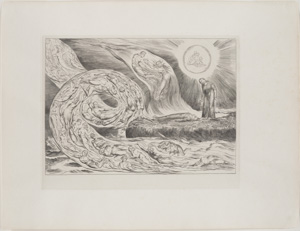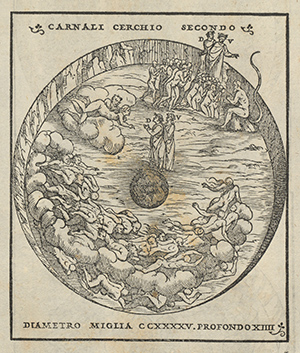Artistic Inspirations
William Blake
William Blake
British, 1757–1827
Engravings for Dante’s Inferno, ca. 1825–27
Engravings printed on chine collé
Each sheet 16 x 20.6 inches (40.6 x 52.3 cm)
Cornell University Library, Rare and Manuscript Collections
(7 images)
- The Circle of the Lustful: Paolo and Francesca, from Inferno, Canto 5
- The Circle of the Corrupt Officials: The Devils Tormenting Ciampolo, from Inferno, Canto 22
- The Circle of the Corrupt Officials: The Devils Mauling Each Other, from Inferno, Canto 22,
- Circle of the Thieves: Agnello Brunelleschi Attacked By a Six-Footed Serpent, from Inferno, Canto 25
- The Circle of the Thieves; Buoso Donati Attacked by the Serpent, from Inferno, Canto 25
- The Circle of the Falsifiers: Dante and Virgil Covering their Noses because of the Stench, from Inferno, Canto 29
- The Circle of Traitors: Dante's Foot Striking Bocca degli Abbate, from Inferno, Canto 32
Poet, artist, and visionary William Blake (1757–1827) was one of the most inventive visual interpreters of Dante. This was in spite of the fact that Blake took up the subject intensively only very late in life, and further that his expressed personal belief in a universally forgiving God set him deeply at odds with Dante’s vision of an afterlife so insistently devoted to retribution. Still, Blake could not help but be captivated by the achievement constituted by the Divine Comedy.
In 1824, Blake’s friend and fellow artist John Linnell engaged him to create a series of images of Dante subjects. A letter to Linnell of February 1827 mentioning that he had pulled proofs from six of the plates is the sole indication of his progress on this suite of engravings.[1] The seven total plates Blake ultimately began were acquired by Linnell at Blake’s death in August of 1827; Linnell did not publish them, however, until 1838 on “India paper” backed on thick wove paper. A second edition, published by Linnell’s son to the specifications of the first, appeared in 1892; however, the presence of drypoint burr still printing strongly on the distant figures of Dante and Virgil in the background of plate 3 seems to indicate this set belongs to the first 1838 printing, which may number as few as thirty-eight total sets.[2] The Cornell prints were likely acquired by the library between 1950 and 1965 when they were exhibited to celebrate Dante’s seven-hundredth birth anniversary. In any case, this acquisition stands as a clear outcome of the momentum of Fiske’s and others’ collecting on Dante at Cornell.
Even in a somewhat incomplete state, Blake’s Dante engravings show staggering sharpness and skill, especially considering his age and ill health at the time he made them. Of these seven plates, the first, treating Inferno Canto 5, the circle of the lustful, and the story of Paolo and Francesca, is the acknowledged masterpiece. Francesca da Rimini and Paolo Malatesta (see Felice Giani, Dante Faints after Hearing Francesca’s Story and Michael Mazur, Paolo and Francesca), who were known to Dante, were adulterous lovers discovered and murdered by Gianciotto Malatesta, Francesca’s husband and Paolo’s brother. Blake’s swirling composition aptly sets Dante’s description “The stormy blast of hell / With restless fury drives the spirits on / Whirl'd round and dash'd amain with sore annoy.”[3] But further details make for a unique reading of Dante’s text, such as the juxtaposition of the couple’s apparition to Dante at left with a scene of their first, fateful kiss, depicted above in the glowing orb above Virgil’s head—a sympathetic or even celebratory presentation of forbidden love that accords with pilgrim Dante’s pity for the lovers as expressed in the verse. At the same time, Blake captures their eternal torment; as Francesca finishes her tale and Dante, “heartstruck,” faints as if dead, the lovers flee, simultaneously held together and torn apart by the maelstrom.
Divine Comedy, 1564 Venice edition with Alessandro Vellutello’s commentary, illustration showing Canto V (1 image)
Despite its many adherents among the ranks of English scholars and amateurs, The Divine Comedy was not translated into English in its entirety until 1802. Blake seems to have been familiar with portions of it from an early point in his career, but for this project relied most heavily on Henry Francis Cary’s English translation, which appeared in 1814. Blake had also taught himself Italian for this purpose; his preferred Italian edition was the 1564 Venice edition featuring Alessandro Vellutello’s commentary (see Divine Comedy, 1564 Venice edition), illustrated with woodcuts after Vellutello’s designs (see Vellutello Drawings and Editions). Because all of the woodcuts illustrating Inferno in this edition are circular in format, it is tempting to see them as a model for the swirling vortex of Blake’s Paolo and Francesca plate, with its whirlwind of condemned lovers.
Footnotes
[1] Bindman, David, and Deirdre Toomey, The Complete Graphic Works of William Blake, London: Thames and Hudson, 487. ↩
[2] Robert N. Essick, “The Printings of Blake’s Dante Engravings,” Blake: An Illustrated Quarterly, vol. 24, no. 3, Winter 1990/1991. As accessed at http://bq.blakearchive.org/24.3.essick ↩
[3] Dante Alighieri, The Vision: Or Hell, Purgatory, and Paradise, translated by H.F. Cary. London: Taylor & Hessey, 1814. ↩

